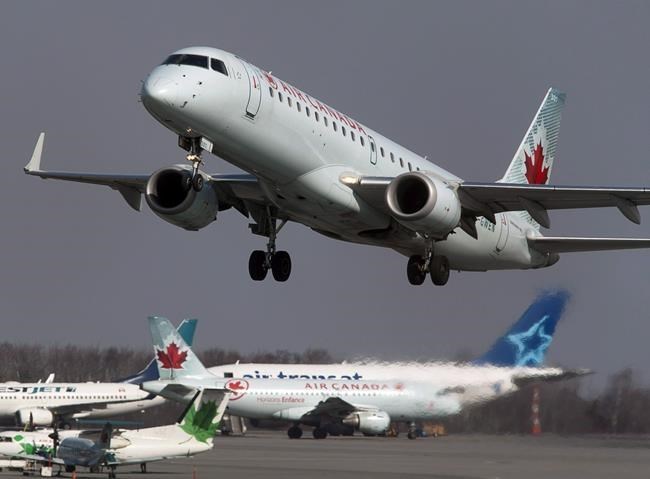Air Canada is trimming the number of planes in its fleet and looking to grow its cargo business as the airline wrestles with a drop of 88 per cent fewer paying passengers than last summer due to the COVID-19 pandemic.
On Monday, the Montreal-based airline said it lost $685 million, or $2.31 per diluted share, in the three months ending Sept. 30, during what is normally its most profitable quarter.
During the same period last year, Air Canada had a profit of $636 million, or $2.35 per diluted share. Third-quarter sales fell 86 per cent from a year ago, down to $757 million from $4.77 billion.
The company says it hopes to save $3 billion between now and 2023 by cutting the number of planes in its hangars. It plans to retire 79 older aircraft, defer the purchase of 18 Airbus planes and 16 Boeing planes, and cancel its plans to buy 10 Boeing 737 MAX 8 and 12 Airbus A220s.
The cost-cutting measures come as the company plans to cut its fourth-quarter capacity by approximately 75 per cent compared with the fourth quarter of 2019.
The company — which has already cut 20,000 jobs, suspended 30 domestic routes and closed eight regional stations this year — said it is eyeing another 95 routes for potential suspension and nine Canadian stations for potential closure.
Air Canada's third-quarter financial results came on the heels of a Sunday announcement by Transport Minister Marc Garneau, who said the government will soon announce aid for the country's airline industry. Garneau said the help will be contingent on carriers providing refunds to passengers whose flights were cancelled.
Chief executive Calin Rovinescu said the company is planning to dive into talks with the government "immediately" this week, and that it will wait to close additional routes and stations depending on how the talks progress.
Despite these money-saving measures, the airline says its net cash burn for the quarter totalled $818 million or approximately $9 million per day, better than its expectations for between $1.35 billion and $1.6 billion or between $15 million and $17 million per day.
Net debt was $4.97 billion as of Sept. 30, up by $2.13 billion from the end of last year.
Lucie Guillemette, executive vice president and chief commercial officer, said Air Canada has struggled more than some U.S. counterparts with the COVID-19 pandemic, as the Chinese government has limited the number of flights from Canada and the bubble of Atlantic provinces dampened domestic travel.
Slashing airplane orders and other costs means that Air Canada will emerge from the COVID-19 pandemic as a smaller company, executives told analysts on a conference call Monday. Rovinescu said Air Canada expects to have a smaller footprint for “several years.”
Despite calling the company’s recovery “fragile” and “uneven,” executives left the door open to expanding through the proposed acquisition of Transat, as well as buying planes later through flexible contracts or bankruptcies.
Executives also said they plan to grow the business in other ways. For one, Air Canada was among the first airlines to reconfigure passenger planes to deliver cargo instead. The company is among contenders for a government contract to transport COVID-19 vaccines, and Guillemette said Air Canada is hoping to leverage the growing popularity of online shopping and the need to transport medical supplies.
Air Canada is also investing in technology to improve health and safety in airports, encouraging rapid testing trials and touchless lounges, and is trying to reach “niche” markets travelling to Qatar and the Caribbean.
This report by The Canadian Press was first published Nov. 9, 2020.
Companies in this story: (TSX:AC)
Anita Balakrishnan, The Canadian Press



